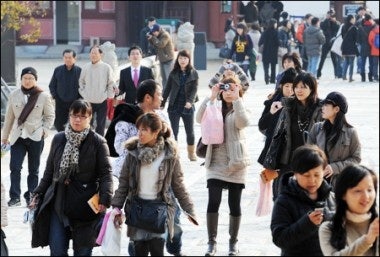Korea's Chosun Ilbo Profiles These Tourist Groups, Discovering Unique Characteristics That Set Chinese & Japanese Tourists Apart#

One of the major developments in global tourism over the past 5-10 years has been the increasing number of Mainland Chinese who are venturing overseas for the first time. As visa restrictions have eased somewhat in a number of countries, and a more confident and growing middle class has emerged, foreign travel has become far easier than in past decades for those who can afford it. Recently, the sustained growth of outbound tourism in China was highlighted in an ETN study:
The total number of outbound travelers grew by close to 12% CAGR during 2004-2008 to touch the statistics of 45 Million visitors in 2008. Sustained economic growth, rising number of affluent people in total population and other parameters have been identified by our research as prime factors that transformed the outbound tourism industry in China.
Tapping into this rising outbound tourism among Mainland Chinese is undoubtedly a top priority for hotels around the world. But how are Chinese tourists different from other tourists? There are, without a doubt, unique cultural characteristics that hotels should take into consideration when courting Mainland Chinese. Much like the way many hotels incorporated some of the comforts that appeal to Japanese tourists in the 1980s, like slippers and green tea, hotels in the next few decades will likely do the same for Chinese tourists.
This week, Korea's Chosun Ilbo ran an article comparing the differences between Chinese and Japanese tourists in Korea, a comparison that is valuable for anyone in the service industries who wants to "localize" their business for the expected wave of Chinese tourists expected to head overseas for years to come:
Chinese tourists, relatively new guests in Korea, have quite different tastes from the Japanese, who have already become customary visitors here. Japanese tourists account for 2.56 million or 39 percent of foreign tourists, while Chinese travelers account for 1.13 million or 17 percent. Experts call for special custom-made tourism strategies to lure as many Chinese tourists as possible.
Japanese Tourists
Japanese itineraries are often geared to women. Most of them include shopping in Myeong-dong, skincare in Apgujeong-dong or Samseong-dong, and visits to the Hanok or traditional Korean houses in the back alleys of Bukchon or trendy shops or cafes in Samcheong-dong -- all in Seoul.
Chinese Tourists
Chinese tourist stayed on average 6.8 nights and spent $1,413 ($207 per day). Many visited Korea for the first time and were on package tours with group visas. Hanatour spokesman Chung Ki-yoon said, "Many Chinese tourists are on package tours of seven Southeast Asian countries."
The problem is that there is a gap between what the Chinese want to see and what Korea has to offer. In the survey, some 44.9 percent of Chinese visitors wanted to enjoy natural scenery, followed by 42.4 percent who wanted to go shopping. The ratio of those who wanted to look at nature in 2008 was down more than 10 points from 2007.
Haban Tour spokesman Woo Hyun-ryang said, "The Chinese are used to huge cultural monuments like Taishan, the Great Wall of China and the Forbidden City, so they usually complain even Mt. Seorak is just like a hill at the back of their village." This means they need other special programs.
Chinese tourists from different regions also had very different tastes. Those from large inland urban areas like Beijing preferred Jeju Island, while those from small or medium-sized cities, such as Guangzhou, Chengdu, or Shenyang liked to visit Myeong-dong or the Dongdaemun traditional market in Seoul. Rich Chinese visitors enjoyed buying designer goods at Lotte or Shinsegae department stores in Myeong-dong, Seoul, or at Centum City in Busan. Food is the biggest problem for the Chinese tourists, who usually complain that Korean food is not fatty enough for them.